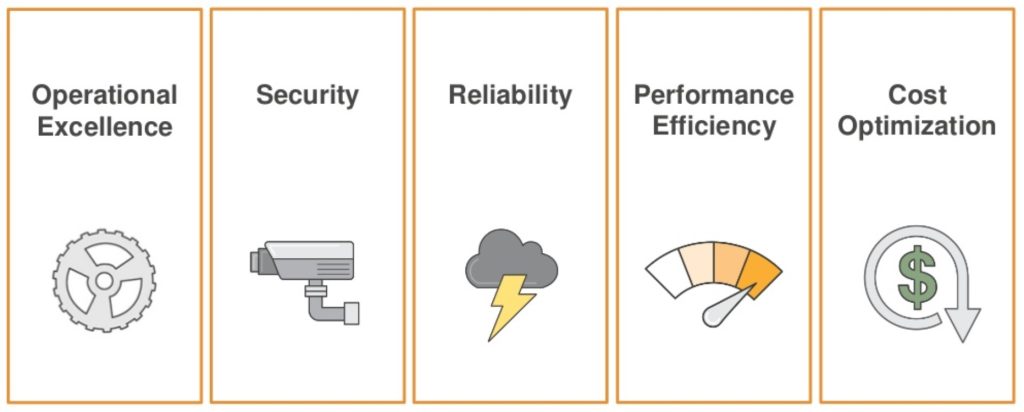AWS Well-Architected Framework
Leveraging the AWS Well-Architected Framework: Building Excellence in Cloud Solutions
The AWS Well-Architected Framework is a comprehensive and systematic approach provided by Amazon Web Services (AWS) to help IT professionals design, build, and manage secure, efficient, cost-effective cloud-based solutions. This framework is based on a collection of best practices and architectural principles drawn from years of experience working with customers to optimize their workloads on the AWS cloud platform. By adhering to the AWS Well-Architected Framework, businesses can ensure that their applications are resilient, performant, and aligned with industry-leading security standards.

The Six Pillars of the AWS, Well-Architected Framework:
The AWS Well-Architected Framework is built on six fundamental pillars, each addressing a specific aspect of cloud architecture. These pillars provide essential guidance and considerations for designing robust and future-proof cloud solutions.
1. Operational Excellence:
Operational Excellence focuses on automating manual processes, continually improving operations, and making data-driven decisions. Organizations can automate infrastructure provisioning and application deployment by leveraging AWS services like AWS CloudFormation and AWS OpsWorks, reducing human error and streamlining operations. Regular monitoring and logging through AWS CloudWatch enable the identification of potential bottlenecks and performance issues, leading to swift remediation and enhanced operational efficiency.
- Automation: Utilizing AWS Well-Architected Solutions and services like AWS Lambda and AWS Step Functions for streamlined operations.
- Monitoring and Logging: Implementing AWS CloudWatch and AWS CloudTrail to gain insights into system health and detect issues.
- Incident Management: Developing robust incident response plans to minimize downtime and resolve issues promptly.
2. Security:
Security is of paramount importance in any cloud environment. This pillar emphasizes implementing a multi-layered security approach to safeguard data, systems, and applications. AWS provides a wide array of security features, such as Identity and Access Management (IAM), Virtual Private Cloud (VPC), and AWS Key Management Service (KMS). Organizations can manage user access to AWS resources through IAM, ensuring the principle of least privilege. VPC enables isolation and segmentation of resources, while KMS allows for creating and managing encryption keys, securing sensitive data at rest and in transit.
- Access Control: Implementing AWS Identity and Access Management (IAM) to manage user permissions and enforce least privilege.
- Encryption: Utilizing AWS Key Management Service (KMS) for data encryption at rest and in transit.
- Compliance Management: Leveraging AWS Config and AWS CloudFormation for auditing and maintaining compliance with industry regulations.
3. Reliability:
The Reliability pillar ensures applications and systems operate continuously and recover from failures. AWS has services for durable object storage and Amazon Relational Database Service (RDS) for highly available databases. Elastic Load Balancing distributes incoming traffic across multiple instances, increasing fault tolerance and minimizing downtime. Organizations can achieve high levels of system reliability by designing redundancy and failover mechanisms.
- Multi-Availability Zone Deployment: Deploying applications across multiple availability zones to ensure high availability and fault tolerance.
- Disaster Recovery: Utilizing AWS Disaster Recovery services to recover from system failures or disasters quickly.
- Load Balancing: Employing AWS Elastic Load Balancing to distribute traffic evenly across instances for enhanced reliability.
4. Performance Efficiency:
To deliver a seamless user experience, the Performance Efficiency pillar concentrates on optimizing resource utilization and maintaining application responsiveness. AWS Auto Scaling automatically adjusts the number of instances to match demand, providing cost savings during low traffic periods and the ability to handle traffic spikes without manual intervention. Caching mechanisms, such as Amazon CloudFront, enhance the delivery of content, reducing latency and improving overall performance. Properly sizing and selecting AWS resources ensures that applications are cost-effective and can handle varying workloads.
- Auto Scaling: Using AWS Auto Scaling to dynamically adjust resources based on demand, optimizing performance and cost.
- Caching: Utilizing AWS ElastiCache to reduce the load on databases and improve application responsiveness.
- Serverless Architecture: Adopting AWS Lambda for event-driven computing to achieve high scalability and cost efficiency.
5. Cost Optimization:
The Cost Optimization pillar aims to control and optimize the costs associated with running workloads on AWS. Organizations can use AWS Cost Explorer to gain visibility into their cloud spending and identify areas for cost optimization. Businesses can save significantly on compute costs by using AWS Spot Instances for non-critical workloads and reserved instances for predictable workloads. Additionally, leveraging AWS Trusted Advisor provides actionable insights to eliminate idle or underutilized resources, leading to substantial cost savings.
- Right Sizing: Analyzing resource utilization and adjusting instance sizes to match actual workload requirements.
- Spot Instances: Utilizing AWS Spot Instances for cost-effective computing when application workload can tolerate interruptions.
- AWS Cost Explorer: Utilizing AWS Cost Explorer to analyze and optimize cloud spending based on usage patterns.
6. Sustainability:
The Sustainability pillar is concerned with creating an architecture that aligns with sustainable business practices and environmental considerations. AWS is firmly committed to sustainability and offers services like AWS Carbon Footprint and AWS Graviton2, enabling organizations to measure and reduce carbon emissions. By selecting energy-efficient instance types and adopting best practices for resource utilization, businesses can contribute to a more sustainable and eco-friendly cloud infrastructure.
- Green Initiatives: Incorporating AWS sustainability programs and renewable energy sources to reduce environmental impact.
- Cloud Migration: Migrating on-premises infrastructure to the cloud to reduce physical hardware and energy consumption.
- Eco-Friendly Architecture: Adopting AWS Well-Architected Best Practices to design environmentally friendly cloud solutions.
Key Points to Remember For the Exam
AWS Certified Cloud Practitioner – Practice Exam (CLF-C01)
- The AWS Well-Architected Framework is essential for all architecture and design decisions on AWS.
- The framework consists of six pillars: Operational Excellence, Security, Reliability, Performance Efficiency, Cost Optimization, and Sustainability.
- Operational Excellence focuses on supporting production workflows, planning for failure, and deploying smaller, reversible changes.
- The Security pillar emphasizes mechanisms to protect systems and data, automate security tasks, and consider all application layers.
- Reliability involves designing systems that work consistently, recover quickly, and scale horizontally for resilience.
- Performance Efficiency aims to effectively use computing resources, remove bottlenecks, and leverage serverless architectures.
- Cost Optimization focuses on delivering resilient solutions at the least cost, utilizing consumption-based pricing, and optimizing resource usage.
- The Sustainability pillar addresses environmental impacts, measuring sustainability goals, and using efficient managed services.
- The six pillars provide different lenses to view cloud architecture, and understanding them helps make sense of AWS services.
- Real-world examples of implementing the pillars include using CodeCommit, CloudTrail, RDS multi-AZ deployments, Lambda, S3 intelligent tiering, and EC2 auto scaling.
- Reviewing the six pillars is crucial for the Certified Cloud Practitioner exam and for practical use in cloud workloads.
Closing Words on AWS Well-Architected Framework
Leveraging the AWS Well-Architected Framework empowers IT professionals to build robust, secure, and efficient cloud solutions that align with business goals and industry best practices. By applying the principles under each pillar, organizations can maximize the benefits of the AWS platform, deliver exceptional user experiences, and optimize costs while positively impacting sustainability efforts. Whether embarking on a new cloud project or assessing existing workloads, the AWS Well-Architected Framework is an indispensable guide to success in the ever-evolving world of cloud computing.




2 Responses
[…] Security is a key part of Amazon’s overall cybersecurity strategy. It enables customers to securely host and manage their applications, data, and infrastructure in […]
[…] how to Configure RDS Alerts in AWS using Event Subscriptions. Setting up event notifications in Amazon RDS using Amazon SNS topics, streaming data to Amazon Kinesis, and then forwarding those notifications […]